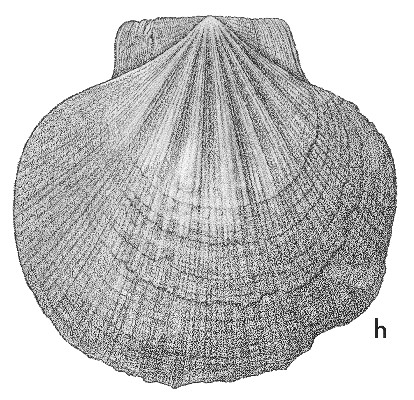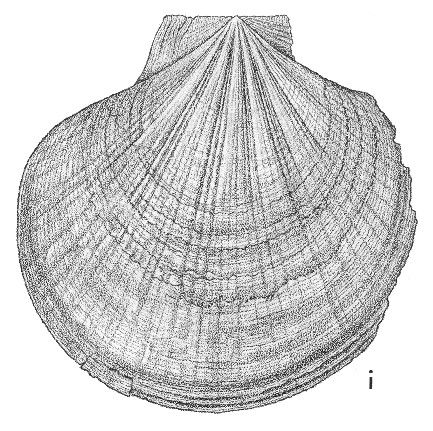
Revised descriptions of New Zealand Cenozoic Mollusca from Beu and Maxwell (1990)

 | Revised descriptions of New Zealand Cenozoic Mollusca from Beu and Maxwell (1990) | 
|
  (Pl. 38i): GS5491, S28/f6594, Pelicaria rugosa-Chlamys patagonica delicatula beds at east side of mouth of Whangaimoana Stream, Palliser Bay, southern Wairarapa, early Nukumaruan (TM2922, GNS) |
  (Pl. 38h): GS5491, S28/f6594, Pelicaria rugosa-Chlamys patagonica delicatula beds at east side of mouth of Whangaimoana Stream, Palliser Bay, southern Wairarapa, early Nukumaruan (TM2922, GNS) |
Beu & Maxwell (1990): Chapter 15; p. 309; pl. 38 h,i.
Synonymy: Pecten semiplicatus Hutton 1873b, p. 30 (not of Alth in Favre, 1869); Pallium mariae Finlay 1927b, p. 526 (new name for Pecten semiplicatus Hutton, preoccupied); Kaparachlamys mariae; Sectipecten mariae, Beu & Maxwell 1990, p. 309, pl. 38h, i.
Type species of Towaipecten Beu, 1995
Classification: Pectinidae
Description: Large for family (80-110 mm high); length variable, from slightly greater than to slightly less than height; left valve markedly more inflated than right, but even left valve little inflated, right valve almost flat. Ears almost equal on the 2 valves, slightly asymmetrical; posterior margin of posterior ears sloping backward moderately, anterior margin of anterior ears sloping slightly backward, sinuous, with broad, shallow, byssal sinus but no ctenolium in right valve. Sculpture of 6 or 7 very low radial folds near umbo of both valves, lower and wider on right valve than on left, fading out by mid-height of large shells; superimposed on them are many low, wide, flat-topped, closely spaced radial costae on right valve (becoming obsolete before outer margin of large shells) and many low, narrow, relatively widely spaced radial costae on left valve (becoming low and wide before outer margin of large shells). Interior features not seen (all are either articulated shells, or in hard limestone).
Comparison: Beu & Maxwell (1990, p. 309) were impressed by the similarity of Towaipecten mariae to weakly sculptured end-members of the highly variable Momoe-a-Toa (northern Chatham Island) population of Sectipecten allani (Pl. 33c). They considered that S. allani is distinguishable from T. mariae only by its slightly wider and more prominent radial folds and the persistence of right-valve costae to the valve margin. However, recognition of the Towaipecten lineage by Beu (1995) demonstrated that this is yet another of the many confusing convergences in pectinid evolution, and T. mariae is much more nearly similar to the Mangapanian species of Towaipecten, T. katieae Beu, 1995. T. mariae differs from T. katieae only in developing radial folds in the shell (plicae), most prominent near the umbones and weakening down the disc to fade into the background by about half the height of large, adult shells. T. mariae appears to have, to some extent, occupied the niche during Nukumaruan time that was occupied by Sectipecten during Late Miocene time. The type species of Kaparachlamys, "Placopecten" hectori (Whenuataru Tuff, Waipipian-Mangapanian, Pitt I., Chatham Islands) lacks radial folds and has many, very uniform, fine radial costae on both valves, as well as a unique microsculpture (for Mesopeplini) of very fine, raised, commarginal ridgelets, but agrees with T. mariae in having the left valve a little more inflated than the right, and in ear shape. It also reached a larger size (large specimens 145 mm high, 155 mm wide) than either Towaipecten or Placopecten, and differs from Placopecten in having many prominent internal rib carinae. The reference of T. mariae to Towaipecten leaves only K. hectori in Kaparachlamys. K. hectori closely resembles American Placopecten species, but the radial sculpture is still finer and the byssal notch is a little shallower in K. hectori than in Placopecten, so the close similarity of K. hectori to Placopecten apparently is superficial.
Distribution: Nukumaruan (supposed Mangapanian occurrences refer to Towaipecten katieae). Scinde Island Limestone, Napier, Hawke's Bay, early Nukumaruan (lectotype of Pecten semiplicatus; Boreham 1965, p. 27); the other syntype(s?) are from Castlepoint, west Wairarapa coast (also early Nukumaruan) where the species is common, although difficult to extract from hard limestone. Common also in limestone bed "C" of Pukenui Limestone (Nukumaruan) in Makara River, east of Martinborough, southern Wairarapa; widely distributed but uncommon in shallow-water shellbeds and coquina limestone in Hawke's Bay and Wairarapa. Towaipecten mariae was apparently a free-lying, actively swimming species of hard-ground environments.
Cite this publication as: "A.G. Beu and J.I. Raine (2009). Revised
descriptions of New Zealand Cenozoic Mollusca from Beu and Maxwell (1990). GNS
Science miscellaneous series no. 27."
© GNS Science, 2009
ISBN
978-0-478-19705-1
ISSN 1177-2441
(Included with a PDF facsimile file
copy of New Zealand Geological Survey Paleontological Bulletin 58 in CD version
from: Publications Officer, GNS Science, P.O. Box 30368 Lower Hutt, New
Zealand)